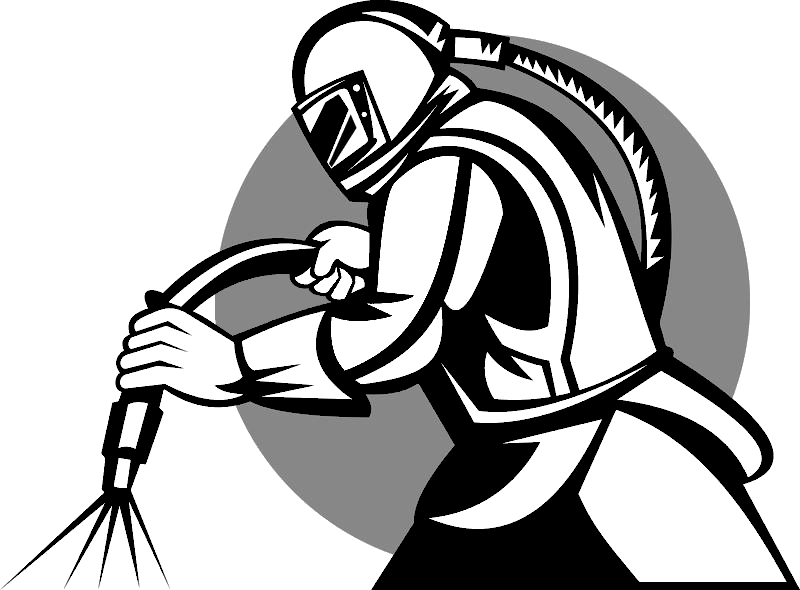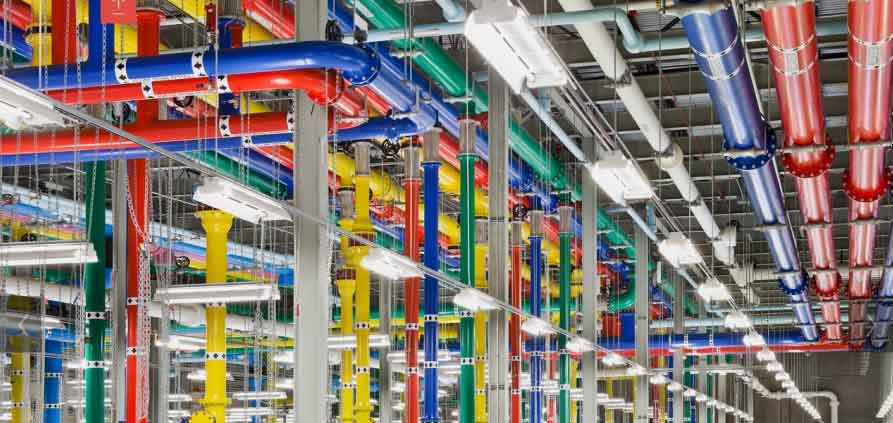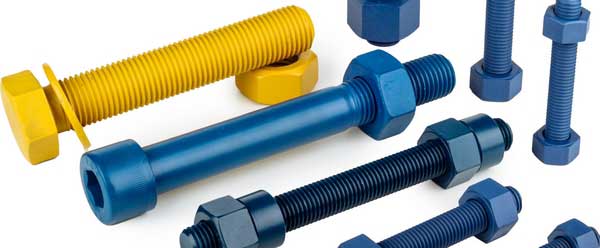Industrial Painting |
Painting of Industrial Equipment
High-quality painting of piping, equipment and structures, is essential to prevent corrosion. It helps ensure the longevity of a constructed installation and low maintenance costs.
Industrial Equipment can be complex and confusing, with a variety of materials, from metal to plastic, and a variety of purposes.. heating and cooling, water, sprinklers, etc. Many of these equipment need to be painted according to strict color codes and laws.

The different types of materials call for different types of paint, and processes of application. Performance Painting Contractors offers a wide variety of different paints, coatings, and more to protect equipment systems.
Implementing corrosion protection for a facility all starts with one important document.. a paint specifications sheet.
Well written paint specifications contain exactly as much detail as they need to make expectations clear and no more. Industrial coatings are more complex than they used to be, and paint specifications need to reflect that complexity.
Paint specification for a project is provided by the customer. Engineering firms can use their own standard paint specifications if allowed by the client.
Effect of Humidity on Surface Preparation and Coating Application
Adhesion of the film on the surface is the key to coating effectiveness. Proper surface preparation enhances adhesion of the film to the surface. When coating a surface prepared by blasting, the real issue is not time.. the key criterion is that the steel temperature shall always be at least 3°C (5°F) higher than the calculated dew point. This safety margin is sufficient for all types of coatings. Consideration of factors such as time, temperature, and humidity must be the responsibility of the inspector.
The following factors are caused by moisture..
- High atmospheric humidity enhances condensation of moisture on the surface.
- Condensation can result in flash rust that causes the coating to fail.
- Surface condensation, if painted over, may result in blistering and delamination.
- It has been estimated that 60 to 80% of all premature coating failures are caused either completely or partially by inadequate or improper surface preparation.
Reference(s) for the article below comes from HMG Paints
Surface Preparation Standards for Painting Steel Surfaces
The effective life of a coating of anti-corrosive paint applied to a steel surface is to a very large extent dependent on how thoroughly the surface has been prepared prior to painting. It is also important to be able to specify clearly the quality of preparation required in each particular case.

Accordingly, a Standard has been approved, specifying four grades of rusting and a number of preparation grades, each establishing a quality grade or preparation prior to protective painting required on a steel surface in a standard rust grade. These grades are presented in this Standard as a series of prints, which provide a clearer and more rapidly appreciated definition than a verbal description.
The standard has been prepared by the Swedish Corrosion Institute in cooperation with the American Society for Testing and Materials, ASTM, and Steel Structures Painting Council, SSPC, USA. In the specifications relating to preparation of surfaces prior to painting, the SSPC and SIS designations correspond as follows..
| SSPC-Vis 1 | SIS 05 59 00 |
| SSPC-SP5 | A Sa 3, B Sa 3, C Sa 3, D Sa 3 |
| SSPC-SP10 | A Sa 2.1/2, B Sa 2.1/2, C Sa 2.1/2, D Sa 2.1/2 |
| SSPC-SP6 | B Sa 2, C Sa 2, D Sa 2 |
| SSPC-SP7 | B Sa1, C Sa 1, D Sa 1 |
This standard refers to surfaces of hot-rolled steel in four different rust grades (A, B, C and D) the same surfaces prepared to two grades of surface quality (St 2 and St 3) by manual scraping and wire-brushing - machine brushing - grinding-etc. The same surfaces prepared to four grades of surface quality (Sa 1, Sa 2, Sa 2.1/2 and Sa 3) by blasting with various abrasives.
Examples.. A steel originally corresponding to rust grade B, which has been scraped or brushed to preparation grade 2 is designated B St 2. A steel surface originally corresponding to rust grade B, which has been prepared by blast cleaning to preparation grade 2.1/2 is designated B Sa 2.1/2.
The standardized rust and preparation grades are defined by colour prints representing full scale view of a part of a surface.
Reference(s) for the article below comes from Performance Painting
Protective Coatings for Piping Systems
All above-ground, underground, and underwater piping systems need a protective coating that can help prevent rust and corrosion. Over the years, innovative products have been developed to address the issue of rust and corrosion in pipes due to different environmental factors, ranging from elevated temperature, moisture, and salinity levels to acid rain and chemicals.
Top Considerations for Choosing Protective Coatings
Before looking into the protective coating formulations available today, it's essential to know that professional painters consider two aspects when choosing a paint system..
- The physical location of the pipeline - When assessing the location of piping systems, the humidity, temperature and UV radiation levels, potential mechanical damage (abrasion, impact, etc.), and chemical exposure (typically occurring in industrial plants are of critical importance. In underground applications, the pH of the soil, residual moisture content, and potential exposure to micro-organisms play a critical role. Before the underwater installation of a pipeline, a complete water chemistry analysis should be performed.
- Atmospheric corrosivity - According to ISO 12944 , there are five atmospheric corrosivity categories.. C1-very low (e.g. heated buildings, such as offices, shops, hotels, etc.); C2-low (non-heated buildings with high relative humidity levels, such as warehouses); C3-medium (e.g. buildings with high humidity and air contaminants, such as laundry facilities); C4-high (industrial areas, such as chemical plants); C5-I-very high (industrial environments with high humidity levels and high concentration of air contaminants, such as automotive paint shops); and C5-M-very high (areas characterized by high salinity).
These two factors will dictate the type and level of surface preparation, the type of paint that will be used, the thickness of the paint film, and recoating intervals. In corrosive environments, the surface preparation and coating operations must be carefully performed and recoating intervals strictly monitored.

External Protective Coatings for Piping Systems
Today, you can find a wide variety of coatings that can ensure long-term protection of piping systems. They're divided into nine distinct categories..
- Zinc-rich epoxy coating - Formulated for steel surfaces, zinc-rich epoxy paint is recommended in applications where high-performance, corrosion-resistant protective coating is required. Besides superior corrosion resistance, the paint is characterized by excellent application, adhesion, fast-drying, and abrasion resistance properties.
- Polyamide epoxy coating - Polyamide epoxy paint is a versatile corrosion resistance formulation that can be used as a primer, intermediate, or finish coat. Polyamide epoxy coatings have excellent weathering, acid, alkali, and water resistance, good adhesion properties, superior film flexibility, and long service life, delivering one of the best protective coating options for piping systems.
- Amine epoxy coating - Forming a hard, abrasion resistant film with superior corrosion resistance, this product is the best fit for highly corrosive environments.
- Aliphatic acrylic-polyester polyurethane coating - With excellent resistance to corrosion and abrasion, this formulation ensures very good weathering performance in mild and aggressive
- Amino-amine epoxy coating - Ensuring good adhesion and corrosion resistance, amino-amine epoxies provide superior moisture and chemical protection.
- Novalac coating - This formulation offers resistance to corrosion, abrasion, and permeation at temperatures of up to 450°F.
- Siloxane epoxy coating - Providing good weathering, abrasion, and acid resistance, siloxane epoxy coating is an excellent choice for high-performance industrial applications.
- Coal tar coating - Since coal tar paint can be used in salt and fresh water, it's one of the best products for C5-M environments.
- Water-based epoxy coating - Though a water-based epoxy formulation offers good solvent, chemical, abrasion resistance, it's usually applied to upgrade previous protective coatings for better performance.
Related Post(s)

Xylan coating is an extreme performance coating, explicitly designed to enhance performance and extend the service life of various industrial products...

ASTM's paint and related coating standards are instrumental in specifying and evaluating the physical and chemical properties of various paints and coatings...